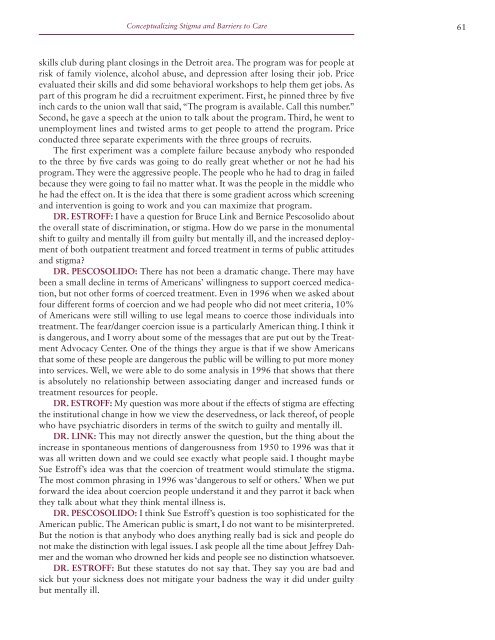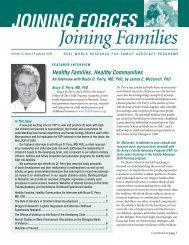stigma and barriers to care - Uniformed Services University of the ...
stigma and barriers to care - Uniformed Services University of the ...
stigma and barriers to care - Uniformed Services University of the ...
Create successful ePaper yourself
Turn your PDF publications into a flip-book with our unique Google optimized e-Paper software.
Conceptualizing Stigma <strong>and</strong> Barriers <strong>to</strong> Care 61<br />
skills club during plant closings in <strong>the</strong> Detroit area. The program was for people at<br />
risk <strong>of</strong> family violence, alcohol abuse, <strong>and</strong> depression after losing <strong>the</strong>ir job. Price<br />
evaluated <strong>the</strong>ir skills <strong>and</strong> did some behavioral workshops <strong>to</strong> help <strong>the</strong>m get jobs. As<br />
part <strong>of</strong> this program he did a recruitment experiment. First, he pinned three by five<br />
inch cards <strong>to</strong> <strong>the</strong> union wall that said, “The program is available. Call this number.”<br />
Second, he gave a speech at <strong>the</strong> union <strong>to</strong> talk about <strong>the</strong> program. Third, he went <strong>to</strong><br />
unemployment lines <strong>and</strong> twisted arms <strong>to</strong> get people <strong>to</strong> attend <strong>the</strong> program. Price<br />
conducted three separate experiments with <strong>the</strong> three groups <strong>of</strong> recruits.<br />
The first experiment was a complete failure because anybody who responded<br />
<strong>to</strong> <strong>the</strong> three by five cards was going <strong>to</strong> do really great whe<strong>the</strong>r or not he had his<br />
program. They were <strong>the</strong> aggressive people. The people who he had <strong>to</strong> drag in failed<br />
because <strong>the</strong>y were going <strong>to</strong> fail no matter what. It was <strong>the</strong> people in <strong>the</strong> middle who<br />
he had <strong>the</strong> effect on. It is <strong>the</strong> idea that <strong>the</strong>re is some gradient across which screening<br />
<strong>and</strong> intervention is going <strong>to</strong> work <strong>and</strong> you can maximize that program.<br />
DR. ESTROFF: I have a question for Bruce Link <strong>and</strong> Bernice Pescosolido about<br />
<strong>the</strong> overall state <strong>of</strong> discrimination, or <strong>stigma</strong>. How do we parse in <strong>the</strong> monumental<br />
shift <strong>to</strong> guilty <strong>and</strong> mentally ill from guilty but mentally ill, <strong>and</strong> <strong>the</strong> increased deployment<br />
<strong>of</strong> both outpatient treatment <strong>and</strong> forced treatment in terms <strong>of</strong> public attitudes<br />
<strong>and</strong> <strong>stigma</strong><br />
DR. PESCOSOLIDO: There has not been a dramatic change. There may have<br />
been a small decline in terms <strong>of</strong> Americans’ willingness <strong>to</strong> support coerced medication,<br />
but not o<strong>the</strong>r forms <strong>of</strong> coerced treatment. Even in 1996 when we asked about<br />
four different forms <strong>of</strong> coercion <strong>and</strong> we had people who did not meet criteria, 10%<br />
<strong>of</strong> Americans were still willing <strong>to</strong> use legal means <strong>to</strong> coerce those individuals in<strong>to</strong><br />
treatment. The fear/danger coercion issue is a particularly American thing. I think it<br />
is dangerous, <strong>and</strong> I worry about some <strong>of</strong> <strong>the</strong> messages that are put out by <strong>the</strong> Treatment<br />
Advocacy Center. One <strong>of</strong> <strong>the</strong> things <strong>the</strong>y argue is that if we show Americans<br />
that some <strong>of</strong> <strong>the</strong>se people are dangerous <strong>the</strong> public will be willing <strong>to</strong> put more money<br />
in<strong>to</strong> services. Well, we were able <strong>to</strong> do some analysis in 1996 that shows that <strong>the</strong>re<br />
is absolutely no relationship between associating danger <strong>and</strong> increased funds or<br />
treatment resources for people.<br />
DR. ESTROFF: My question was more about if <strong>the</strong> effects <strong>of</strong> <strong>stigma</strong> are effecting<br />
<strong>the</strong> institutional change in how we view <strong>the</strong> deservedness, or lack <strong>the</strong>re<strong>of</strong>, <strong>of</strong> people<br />
who have psychiatric disorders in terms <strong>of</strong> <strong>the</strong> switch <strong>to</strong> guilty <strong>and</strong> mentally ill.<br />
DR. LINK: This may not directly answer <strong>the</strong> question, but <strong>the</strong> thing about <strong>the</strong><br />
increase in spontaneous mentions <strong>of</strong> dangerousness from 1950 <strong>to</strong> 1996 was that it<br />
was all written down <strong>and</strong> we could see exactly what people said. I thought maybe<br />
Sue Estr<strong>of</strong>f’s idea was that <strong>the</strong> coercion <strong>of</strong> treatment would stimulate <strong>the</strong> <strong>stigma</strong>.<br />
The most common phrasing in 1996 was ‘dangerous <strong>to</strong> self or o<strong>the</strong>rs.’ When we put<br />
forward <strong>the</strong> idea about coercion people underst<strong>and</strong> it <strong>and</strong> <strong>the</strong>y parrot it back when<br />
<strong>the</strong>y talk about what <strong>the</strong>y think mental illness is.<br />
DR. PESCOSOLIDO: I think Sue Estr<strong>of</strong>f’s question is <strong>to</strong>o sophisticated for <strong>the</strong><br />
American public. The American public is smart, I do not want <strong>to</strong> be misinterpreted.<br />
But <strong>the</strong> notion is that anybody who does anything really bad is sick <strong>and</strong> people do<br />
not make <strong>the</strong> distinction with legal issues. I ask people all <strong>the</strong> time about Jeffrey Dahmer<br />
<strong>and</strong> <strong>the</strong> woman who drowned her kids <strong>and</strong> people see no distinction whatsoever.<br />
DR. ESTROFF: But <strong>the</strong>se statutes do not say that. They say you are bad <strong>and</strong><br />
sick but your sickness does not mitigate your badness <strong>the</strong> way it did under guilty<br />
but mentally ill.




